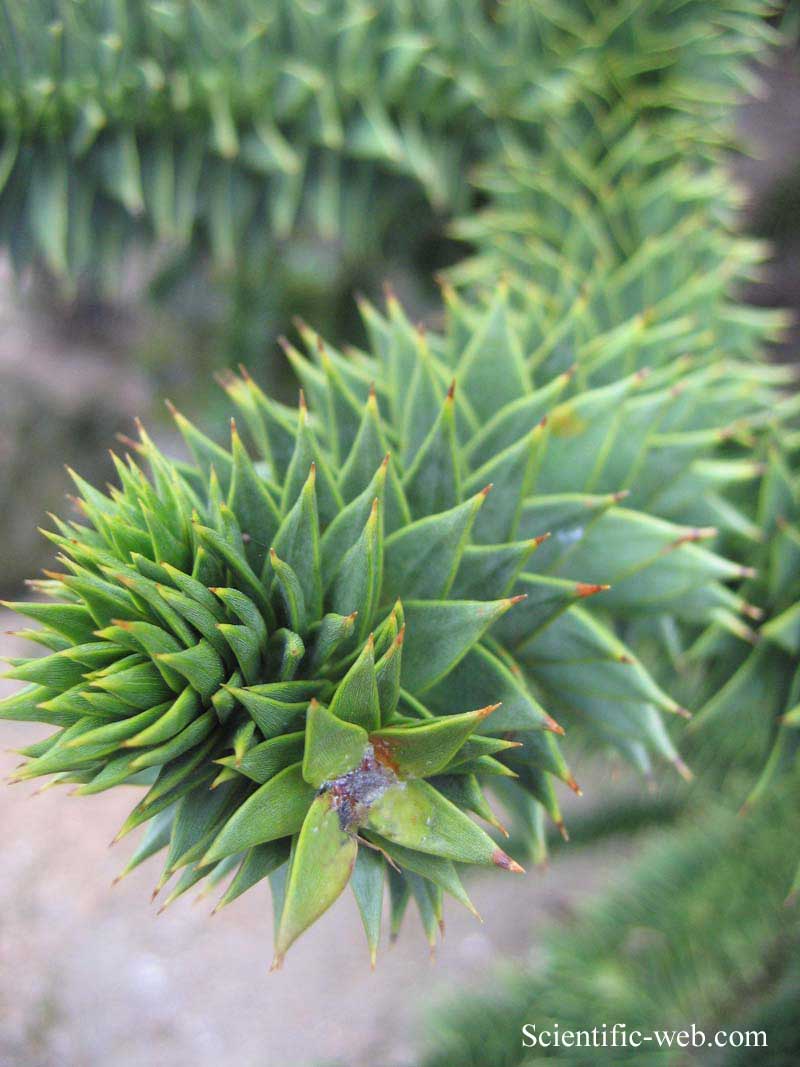Araucaria araucana, Photo: Michael Lahanas Cladus: Eukaryota
Araucaria araucana, Photo: Michael Lahanas Name Araucaria araucana (Molina) K.Koch Basionym: Pinus araucana Molina, Sag. Stor. Nat. Chili: 182 (1782) References * Dendrologie 2(2):206. 1873 Vernacular names ----------- Araucaria araucana (Monkey-puzzle) is the hardiest species in the conifer genus Araucaria. It is native to south-central Chile and west central Argentina, and is an evergreen tree growing to 40 m tall and 2 m trunk diameter. Because of the species' great age it is sometimes described as a living fossil. Araucaria araucana is the national tree of Chile.
The leaves are thick, tough and scale-like, triangular, 3–4 cm long, 1–3 cm broad at the base, and with sharp edges and tip. They persist for 10–15 years or more, so cover most of the tree except for the older branches. It is usually dioecious, with the male and female cones on separate trees, though occasional individuals bear cones of both sexes. The male (pollen) cones are oblong and cucumber-shaped, 4 cm long at first, expanding to 8–12 cm long by 5–6 cm broad at pollen release. The tree is wind pollinated. The female (seed) cones, which mature in autumn about 18 months after pollination, are globose, large, 12–20 cm diameter, and hold about 200 seeds. The cones disintegrate at maturity to release the 3–4 cm long nut-like seeds, which are then dispersed by jays and squirrels. Habitat Its native habitat is the lower slopes of the Chilean and Argentinian south-central Andes, typically above 1000 m, in regions with heavy snowfall in winter. Juvenile trees exhibit a broadly pyramidal or conical habit which naturally develops into the distinctive umbrella form of mature specimens as the tree ages[1]. It prefers well drained, slightly acidic, volcanic soil but will tolerate almost any soil type provided drainage is good. Cultivation and uses It is a popular garden tree, planted for its unusual effect of the thick, 'reptilian' branches with a very symmetrical appearance. It prefers temperate climates with abundant rainfall, tolerating temperatures down to about −20 °C. It is far and away the hardiest member of its genus, and can grow well in western Europe (north to the Faroe Islands and Smøla[2] in western Norway), the west coast of North America (north to the Queen Charlotte Islands in Canada) and locally on the east coast as well, and in New Zealand and southeastern Australia. It is tolerant of coastal salt spray, but does not like exposure to pollution. The seeds are edible, similar to large pine nuts, and are extensively harvested in Chile. The tree has some potential to be a food crop in other areas in the future, thriving in climates with cool oceanic summers (e.g. western Scotland) where other nut crops do not grow well. A group of six female trees with one male for pollination could yield several thousand seeds per year. Since the cones drop, harvesting is easy. The tree however does not yield seeds until it is around 30–40 years old, which discourages investment in planting orchards (although yields at maturity can be immense); once established, it can live possibly as long as 1,000 years (Gymnosperm Database). Once valued because of its long, straight trunk, its current rarity and vulnerable status mean its wood is now rarely used; it is also sacred to some members of the Mapuche Native American tribe.[3] Before the tree became protected by law in 1971, there were lumber-mills in Araucanía Region which specialized in Araucarias. This species is listed in the CITES Appendix I as an endangered species. [4] Discovery and naming First found in Chile in the 1780s, it was named Pinus araucana by Molina in 1782. In 1789, de Jussieu had erected a new genus called Araucaria based on the species, and in 1797 Pavón published a new description of the species which he called Araucaria imbricata (an invalid name, as it did not use Molina's older species epithet). Finally in 1873, after several further redescriptions, Koch published the combination Araucaria araucana, validating Molina's name in the genus. The name araucana is derived from the native Araucanians who used the nuts (seeds) of the tree in Chile. A group of Araucanians living in the Andes, the Pehuenches, owe their name to their diet based on harvesting of the Araucaria seeds. Pehuen means Araucaria and che people in Mapudungun. Common names In Britain prior to 1850, it had been known as "Joseph Bank's Pine" or "Chile Pine", though it is not a true pine. The origin of the popular English name Monkey-puzzle derives from its early cultivation in Britain in about 1850, when the species was still very rare in gardens and not widely known. The proud owner of a young specimen at Pencarrow garden near Bodmin in Cornwall was showing it to a group of friends, and one made the remark "It would puzzle a monkey to climb that"; as the species had no existing popular name, first 'monkey-puzzler', then 'monkey-puzzle' stuck.[5] In France it is known as "désespoir des singes" or "monkeys' despair". The species' Mapuche name Pehuén is now becoming more widely used as an alternative common name in English. References 1. ^ "Araucaria Araucana by Michael A. Arnold". http://aggie-horticulture.tamu.edu/syllabi/308/Lists/second%20ed/Araucariaaraucana.pdf. Source: Wikispecies, Wikipedia: All text is available under the terms of the GNU Free Documentation License |
|


